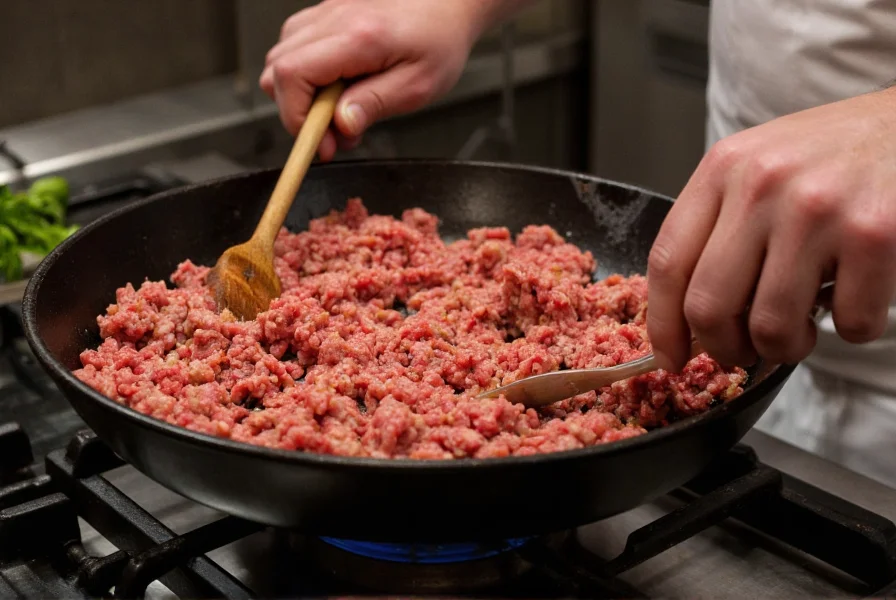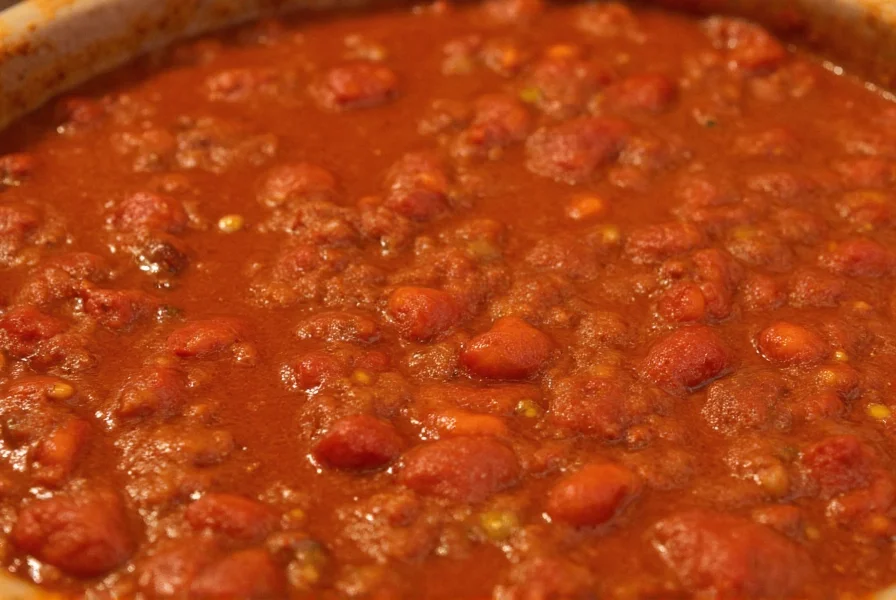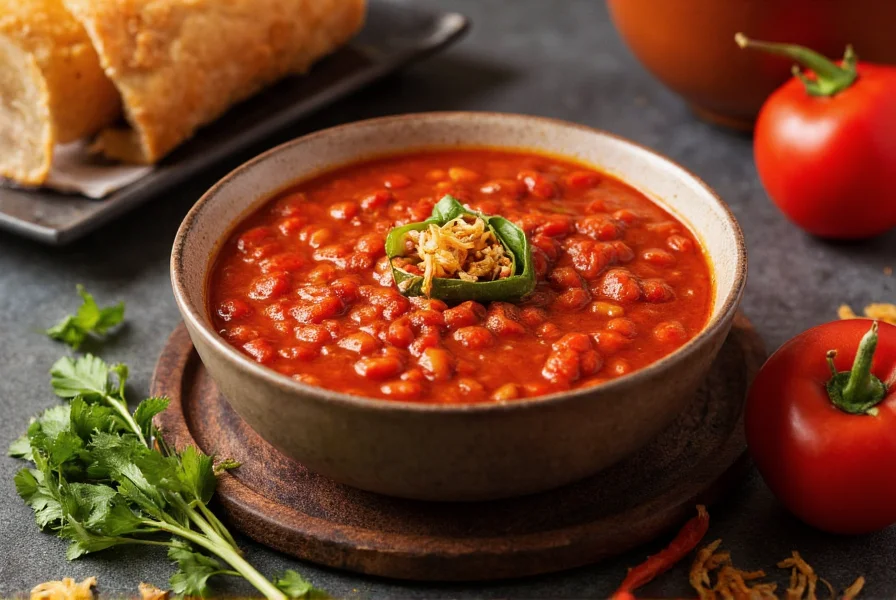
Building the Foundation: Meat Selection and Preparation
What makes a good chili recipe starts with quality meat selection and proper preparation. While traditional Texas-style chili uses only meat and spices, most home cooks incorporate a blend of proteins. Ground chuck with 80% lean-to-fat ratio provides ideal richness without excessive grease. For depth of flavor, brown the meat in batches without overcrowding the pot—this Maillard reaction creates complex flavor compounds that boiling or steaming cannot achieve.
Consider adding complementary proteins like cubed chuck roast for texture variation or smoked meats like brisket for authentic regional flavor. When preparing meat for chili, resist the urge to rinse after browning; those browned bits (fond) contain concentrated flavor that forms the flavor base when deglazed with liquid.
The Flavor Base: Aromatics and Vegetables
Understanding what makes a good chili involves mastering the aromatic foundation. Onions, garlic, and bell peppers form the "holy trinity" of chili aromatics. For optimal flavor development, sauté these ingredients slowly in the rendered meat fat until translucent but not caramelized—this extracts maximum flavor without bitterness.
Professional chili makers often add additional vegetables like carrots (for subtle sweetness) or mushrooms (for umami depth). The key is maintaining balance—vegetables should enhance, not dominate. Chop ingredients uniformly to ensure even cooking, and remember that fresh garlic added late in the sauté process preserves its bright flavor better than early addition.
Mastering the Spice Profile
What makes a good chili taste better than average lies in the spice balance. While chili powder forms the backbone, relying solely on pre-mixed blends limits flavor complexity. Create your own blend using:
| Essential Spice | Function | Proportion (per pound of meat) |
|---|---|---|
| Ancho chili powder | Fruitiness and mild heat | 2 tablespoons |
| Ground cumin | Earthy depth | 1.5 tablespoons |
| Paprika (smoked) | Smoky dimension | 1 tablespoon |
| Oregano (Mexican) | Herbal complexity | 1 teaspoon |
Toasted whole spices ground fresh provide superior flavor to pre-ground versions. Bloom spices in oil for 30 seconds before adding liquids—this process activates essential oils and integrates flavors more effectively than adding dry spices to the finished product.
Liquid Components and Consistency
The proper liquid ratio determines whether your chili achieves that perfect thick-but-saucy consistency. What makes a good chili recipe stand out is understanding that liquid reduces during cooking, so start with more than you think you'll need. A 3:1 ratio of liquid to solid ingredients provides adequate moisture for the long simmer while allowing proper reduction.
Choose your liquid components strategically:
- Tomatoes: Canned fire-roasted tomatoes add depth; avoid fresh tomatoes which can make chili watery
- Broth: Rich beef broth enhances meatiness; avoid chicken broth which competes with beef flavors
- Beer: Dark stout adds malty complexity and helps tenderize meat
- Coffee: A small amount (¼ cup) enhances bitterness balance without noticeable coffee flavor
Secret Ingredients and Flavor Enhancers
Professional chefs know what makes a good chili exceptional often comes from unexpected additions. These secret ingredients work on scientific principles of flavor enhancement:
- Umami boosters: A teaspoon of fish sauce (undetectable in final product) or soy sauce adds glutamates that intensify savory notes
- Acid components: A splash of apple cider vinegar or lime juice at the end brightens flavors and balances richness
- Sweetness balancing: A small amount of dark chocolate or cocoa powder rounds out acidity without adding sweetness
- Texture elements: A tablespoon of masa harina thickens while adding authentic corn flavor

Cooking Technique: Time and Temperature
How long to simmer chili for best results is perhaps the most overlooked aspect of what makes a good chili. Authentic chili requires slow development of flavors through proper cooking technique:
- Initial simmer: Bring to a boil, then immediately reduce to the barest simmer—bubbles should barely break the surface
- Covered vs. uncovered: Start covered for first hour, then partially uncovered to allow controlled reduction
- Minimum cooking time: 2 hours for ground meat versions; 3+ hours for cubed meat recipes
- Resting period: Refrigerate overnight—this allows flavors to fully integrate and improves texture
Rushing the cooking process prevents the complex chemical reactions that develop deep flavor. The ideal chili simmers gently for hours, with occasional stirring to prevent sticking. Temperature control is crucial—too hot and flavors become harsh; too cool and development stalls.
Common Mistakes to Avoid
Understanding what makes a good chili involves recognizing pitfalls that undermine even well-intentioned efforts. The most frequent errors include:
- Over-spicing: Adding excessive heat without balancing other flavor components
- Under-seasoning: Failing to adjust salt levels throughout cooking process
- Rushing the process: Simmering for insufficient time prevents flavor integration
- Incorrect thickening: Using flour instead of natural reduction creates pasty texture
- Adding beans improperly: Canned beans added too early break down; dried beans require separate preparation
Season your chili incrementally—taste after each addition and allow 15-20 minutes for flavors to integrate before adjusting further. Remember that chili always tastes better the next day as flavors continue to meld during storage.
Personalizing Your Perfect Chili
What makes a good chili for you depends on personal preferences and regional traditions. Consider these customization options:
- Heat level: Adjust with cayenne pepper or fresh chilies added at different stages (early for integrated heat, late for brighter spice)
- Texture: Some prefer smooth chili; others enjoy chunkier meat and vegetable components
- Bean debate: Traditional Texas chili contains no beans, but many regions embrace them—use kidney, pinto, or black beans based on preference
- Regional variations: Cincinnati-style (spicy-sweet with chocolate), New Mexico (green chili base), or Midwest (tomato-heavy)
The best chili reflects your personal taste while respecting fundamental cooking principles. Document your adjustments each time you make chili to refine your perfect recipe through iterative improvement.
Conclusion: The Essence of Exceptional Chili
What makes a good chili ultimately comes down to understanding and balancing its fundamental elements. Quality ingredients properly prepared, thoughtful spice combinations, adequate cooking time, and careful seasoning adjustments transform simple components into a complex, satisfying dish. The most important ingredient is patience—allowing time for flavors to develop and integrate separates good chili from truly exceptional chili. By mastering these principles rather than following rigid recipes, you'll develop the intuition to create consistently delicious chili that reflects your personal taste preferences.
Frequently Asked Questions
How long should chili simmer for optimal flavor development?
For optimal flavor development, chili should simmer for a minimum of 2 hours for ground meat versions and 3+ hours for cubed meat recipes. The extended cooking time allows flavors to fully integrate and complex chemical reactions to occur. Many chili experts recommend refrigerating and reheating the chili the next day, as this additional resting period further improves flavor integration and texture.
What's the secret to making chili less acidic?
To reduce acidity in chili, add a small amount (¼-½ teaspoon) of baking soda which neutralizes acid, or incorporate natural sweeteners like a tablespoon of brown sugar, a small piece of dark chocolate, or grated carrot. A splash of cream or a dollop of sour cream when serving also balances acidity. Remember to adjust seasoning after modifying acidity, as these changes affect overall flavor balance.
Should I use fresh or dried spices when making chili?
For the best results, use a combination of both. Dried spices form the foundation of chili's flavor profile and should be toasted in oil to activate their essential oils. Fresh spices like cilantro added at the end provide bright top notes. Whole dried chilies rehydrated and blended into the base offer superior depth compared to pre-ground chili powder alone. Always check expiration dates—spices lose potency after 6-12 months.
What's the ideal meat-to-liquid ratio for perfect chili consistency?
The ideal starting ratio is approximately 3 parts liquid to 1 part solid ingredients. As chili simmers, liquid reduces significantly, so beginning with adequate moisture prevents drying out during the long cooking process. The perfect finished consistency should coat the back of a spoon without being runny—thick enough to hold its shape briefly but still pourable. Adjust consistency during the final hour of cooking by either reducing uncovered to thicken or adding small amounts of broth to thin.











 浙公网安备
33010002000092号
浙公网安备
33010002000092号 浙B2-20120091-4
浙B2-20120091-4